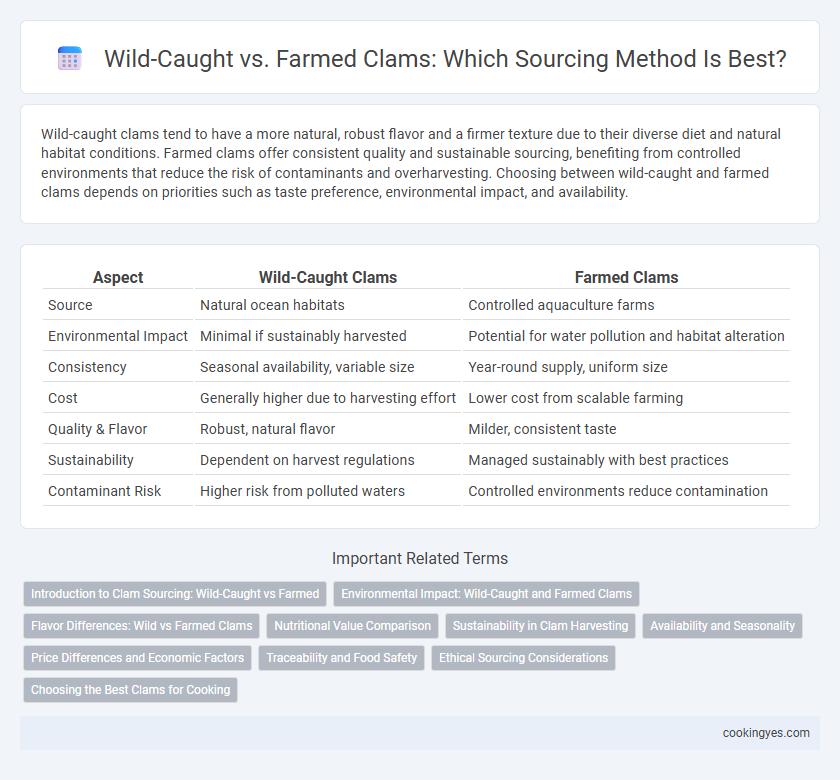Wild-caught clams tend to have a more natural, robust flavor and a firmer texture due to their diverse diet and natural habitat conditions. Farmed clams offer consistent quality and sustainable sourcing, benefiting from controlled environments that reduce the risk of contaminants and overharvesting. Choosing between wild-caught and farmed clams depends on priorities such as taste preference, environmental impact, and availability.
Table of Comparison
| Aspect | Wild-Caught Clams | Farmed Clams |
|---|---|---|
| Source | Natural ocean habitats | Controlled aquaculture farms |
| Environmental Impact | Minimal if sustainably harvested | Potential for water pollution and habitat alteration |
| Consistency | Seasonal availability, variable size | Year-round supply, uniform size |
| Cost | Generally higher due to harvesting effort | Lower cost from scalable farming |
| Quality & Flavor | Robust, natural flavor | Milder, consistent taste |
| Sustainability | Dependent on harvest regulations | Managed sustainably with best practices |
| Contaminant Risk | Higher risk from polluted waters | Controlled environments reduce contamination |
Introduction to Clam Sourcing: Wild-Caught vs Farmed
Wild-caught clams are harvested from natural marine environments, offering diverse flavors influenced by their specific habitats and water quality. Farmed clams are cultivated in controlled aquaculture settings, ensuring consistent size, availability, and reducing environmental impact on wild populations. Choosing between wild-caught and farmed clams depends on factors such as sustainability preferences, taste profiles, and supply reliability.
Environmental Impact: Wild-Caught and Farmed Clams
Wild-caught clams support natural ecosystem balance by maintaining sediment quality and providing habitat for marine species but can face overharvesting risks that threaten biodiversity. Farmed clams offer a sustainable alternative with lower carbon footprints, minimal feed requirements, and the ability to filter water, improving coastal water quality. However, improper farm management may lead to local habitat disruption and nutrient pollution, emphasizing the need for responsible aquaculture practices.
Flavor Differences: Wild vs Farmed Clams
Wild-caught clams exhibit a more robust and briny flavor profile due to their natural diet and varied habitat, enhancing their taste complexity. Farmed clams tend to have a milder, sweeter flavor, influenced by controlled feeding and stable environmental conditions. Flavor intensity in wild clams often appeals to gourmet chefs seeking distinct seafood characteristics, while farmed clams offer consistency and subtlety preferred in mass-market culinary uses.
Nutritional Value Comparison
Wild-caught clams typically have higher mineral content, including zinc and iron, compared to farmed clams due to their natural diet and environment. Farmed clams, however, often contain more consistent levels of omega-3 fatty acids and protein because of controlled feeding practices. Both sources provide essential nutrients like vitamin B12 and selenium, but wild-caught clams may offer a richer micronutrient profile overall.
Sustainability in Clam Harvesting
Wild-caught clams are typically harvested using methods that have minimal impact on marine ecosystems, supporting biodiversity and maintaining natural habitats. Farmed clams offer sustainable benefits by reducing pressure on wild populations and promoting efficient resource use through controlled environments and selective breeding. Both approaches contribute to sustainable clam sourcing when managed responsibly, balancing ecological health with economic viability.
Availability and Seasonality
Wild-caught clams are subject to natural seasonal cycles, leading to fluctuating availability primarily during spring and early summer when populations peak. Farmed clams offer consistent, year-round supply due to controlled environments, reducing dependence on seasonal changes. Sustainable farming practices ensure steady clam sourcing without depleting wild stocks, supporting stable market availability.
Price Differences and Economic Factors
Wild-caught clams often command higher market prices due to limited supply and seasonal availability, driving up demand among consumers seeking natural seafood. Farmed clams offer a more consistent, cost-effective source as controlled aquaculture methods reduce harvesting risks and stabilize output. Economic factors such as production costs, environmental regulations, and market logistics further influence price disparities between wild-caught and farmed clam products.
Traceability and Food Safety
Wild-caught clams offer natural traceability through their capture locations and environmental conditions, providing transparency in sourcing. Farmed clams undergo controlled monitoring, ensuring consistent food safety standards and minimizing contamination risks through regulated aquaculture practices. Both methods emphasize traceability and food safety, but farmed clams benefit from systematic oversight, while wild-caught rely on careful ecological tracking.
Ethical Sourcing Considerations
Wild-caught clams provide a naturally sustainable option by supporting ecosystem balance and avoiding the environmental impacts of intensive farming practices. Farmed clams require careful management to prevent habitat degradation, water pollution, and genetic diversity loss. Ethical sourcing prioritizes transparency, habitat protection, and adherence to responsible harvesting regulations to minimize ecological disruption.
Choosing the Best Clams for Cooking
Wild-caught clams offer a naturally diverse diet and cleaner environments, resulting in firmer texture and more complex flavor profiles ideal for gourmet cooking. Farmed clams provide consistent quality, sustainability, and controlled farming conditions that reduce contamination risks and are often more affordable for everyday meals. Prioritizing wild-caught clams ensures superior taste experiences, while farmed clams contribute to eco-friendly sourcing and consistent availability for various culinary needs.
Wild-caught vs Farmed for clam sourcing Infographic

 cookingyes.com
cookingyes.com